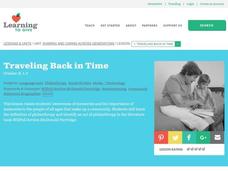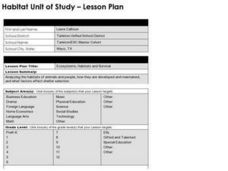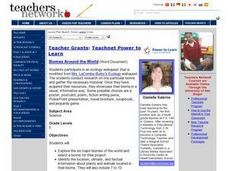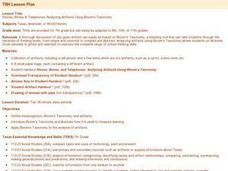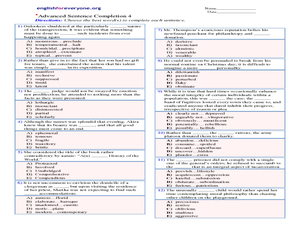Curated OER
Wolfgang Amadeus Mozart
Students study the life and music of the composer Wolfgang Amadeus Mozart. They practice listening for the downbeat of a musical selection. They participate in a physical exercise where they march around in a circle and clap to the...
Curated OER
Integration of Photography with Other Learning Experiences
Students studied photography in order to establish individual vision, creative thinking and writing skills while communicating ideas and emotions. They exhibit their work.
Curated OER
Spend, Save, Invest or Donate
Students explore the concept of philanthropy. In this personal finance lesson, students consider economic choices and why people donate to causes. Students investigate the processes of borrowing money and investing money in the lesson as...
Curated OER
Sharing Our Legacy of Giving
Students explore the concept of philanthropy. For this service learning lesson, students research or interview a local philanthropist. Students write a biography about the philanthropist and share it with others.
Curated OER
Traveling Back in Time
Students recall memories from childhood and share them with the class. In this memory activity, students listen to the book Wilfrid Gordon McDonald Partridge and determine the types of memories people have. Students look for items from...
Curated OER
Where Does It All Come From?
Students analyze a reading selection. In this community instructional activity, students read a story about how community helps a family in need. Students discuss their community organizations and how they help those in need.
Curated OER
Ecosystems, Habitats and Survival
Students analyze the habitats of animals and people, how they are developed and maintained, and what factors affect shelter selection. They create a classified ad that describes a specific animal's habitat.
Curated OER
Biomes Around The World
Fifth graders explore the six major biomes found in the world and choose one for further research and presentation. Using internet sources, they identify the major characteristics of their biome and synthesize their information into a...
Curated OER
Life Shields
Students create shields representing what they value most. In this art lesson, students observe shields in the book The Legend of the Bluebonnet and create their own shields depicting the four things they value most in life.
Curated OER
I Am a Star
Learners explore the unique qualities of themselves and others. For this character education lesson, students read the book A Unicorn Named Beulah Mae and create a paper star displaying their unique personality traits.
Curated OER
Comparative Sculpture Lesson Plan
Fifth graders view original artwork, define the art form sculpture, discuss similarities and differences between the examples provided, discuss the three-dimensional quality of each example given, and create and critique their own artwork.
Curated OER
Stones, Bones & Telephones: Analyzing Artifacts Using Bloom's Taxonomy
Seventh graders define metacognition, Bloom's Taxonomy, and artifacts. They, in groups, try to identify a mystery artifact using the Artifact Analysis sheet. They present their findings to the class.
Curated OER
Henry Wadsworth Longfellow's "Haunted Houses"
Learners read and analyze Henry Wadsworth Longfellow's poem, "Haunted Houses." They define key vocabulary terms, discuss the poem's technical aspects, and create an original poem about a haunted house or a haunted place.
Curated OER
Henry Wadsworth Longfellow's "The Slave's Dream"
Students examine Henry Wadsworth Longfellow's contribution to the anti-slavery movement. They read and analyze a poem, identify the poem's techniques, and write a critique of the poem, "The Slave's Dream."
Curated OER
Analyzing Artifacts Using Bloom's Taxonomy
Seventh graders apply Blooms Taxonomy to analyze a collection of artifacts. They define and discuss the nature of artifacts and work in groups to complete handouts. Students analyze an object (stone pipe) on a mystery artifact analysis...
Curated OER
The Concept of Wa I
Twelfth graders compare how disputes are resolved in Japan and the United States. They read the case, state the facts of the case, and identify the issues involved. They determine that preserving harmonious relationships is more...
Curated OER
POWWOW
Young scholars investigate the significance of the Powwow to the Native Americans. They write a story about a special tradition or custom from their own family, play Native American children's games, prepare Indian fry bread, and...
Curated OER
Planets Online
Students use bookmarked Internet web sites about Space to gather information and use desktop publishing software to write assignments. They participate in various web assignments on provided links to study the planets and the solar system.
Curated OER
Plant, Point and Record the Life Cycles of Plants
Students examine the life cycle of plants. Individually, they are given a digital camera in which they take pictures of plants in the various stages of the life cycle. To end the lesson, they plant their own flower bed in the classroom...
Curated OER
Reaction rates and Equilibrium
Students listen to a lecture on the collision theory. They discuss the reactant and product changes during a chemical reaction. Students are taught the factors affecting reaction rates. They complete a lab on entropy, heat and free...
Curated OER
What is Sacrifice?
Learners explore the Aztec culture. For this world cultures lesson, students examine the concept of sacrifice and discuss when sacrifice is justified versus unnecessary. Learners come up with a personal way to make a justified sacrifice.
Curated OER
Advanced Sentence Completion 4
In this sentence completion worksheet, students choose the best word(s) to complete twelve sentences. Students must fill in more than one word per sentence in some instances.
Curated OER
What is Sacrifice?
Seventh graders explore different forms of sacrifice. In this World History lesson, 7th graders determine the reasons why people make sacrifices. Students write a personal goal to make a small sacrifice.
Curated OER
Fun With Calendars
Students use four numbers to find calendar dates that form square numbers. In this square numbers instructional activity, students use algebraic equations to calculate and locate number patterns using a monthly calendar.
Other popular searches
- Gifted and Talented
- Gifted and Talented Math
- Gifted and Talented Education
- Gifted and Talented Lessons
- Gifted and Talented Reading
- Gifted and Talented Science
- Gifted and Talented Art
- Gifted and Talented Writing
- Gifted and Talented Students
- Gifted and Talented Music
- Gifted Talented
- Gifted/talented






